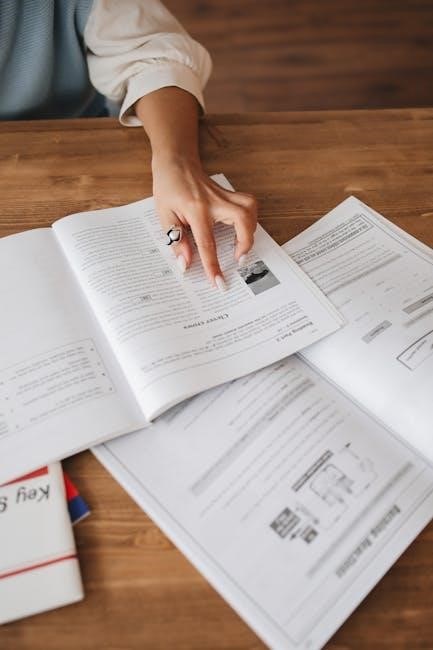concepts to analyze shapes and solve problems effectively always.
Definition of Trapezoids
A trapezoid is a quadrilateral with exactly one pair of parallel sides, which are called the bases of the trapezoid, and the other pair of sides are called the legs. The definition of a trapezoid is important to understand in order to identify and work with this type of quadrilateral. According to the 6-6 study guide and intervention, a trapezoid has a midsegment or median that connects the midpoints of the legs, and its measure is equal to one-half the sum of the lengths of the bases. This definition is crucial in understanding the properties and behavior of trapezoids, and it is used as a foundation for solving problems and proving relationships in geometric figures, as outlined in the mathematics Florida standards. Using this definition, students can identify and analyze trapezoids in different contexts.
Definition of Kites

A kite is a quadrilateral with exactly two pairs of consecutive congruent sides, which means that the opposite sides of a kite are not congruent or parallel. The definition of a kite is important to understand in order to identify and work with this type of quadrilateral. According to the 6-6 study guide and intervention, a kite has diagonals that are perpendicular, and this property can be used to solve problems and prove relationships in geometric figures. The definition of a kite is also related to the concept of congruence and symmetry, and it is used to analyze and identify kites in different contexts. Using this definition, students can develop their understanding of kites and their properties, and apply this knowledge to solve problems and prove theorems in geometry, as outlined in the mathematics curriculum. This definition is a fundamental concept in geometry.

Properties of Trapezoids
Properties of trapezoids include midsegment and bases, using math concepts to analyze and solve problems with these shapes always and effectively in geometry classes every day.
Midsegment of a Trapezoid
The midsegment of a trapezoid is a segment that connects the midpoints of the legs of the trapezoid, and its measure is equal to one-half the sum of the lengths of the bases. This property is useful in solving problems involving trapezoids, as it allows us to find the length of the midsegment using the lengths of the bases. By using this property, we can also find the length of the bases using the length of the midsegment. The midsegment is also parallel to the bases of the trapezoid, which makes it a useful tool in geometry. With the help of mathematical concepts and formulas, we can easily calculate the length of the midsegment and use it to solve problems involving trapezoids. This concept is essential in understanding the properties of trapezoids and applying them to real-world problems. Using this property, we can solve problems efficiently and effectively.
Using Properties of Trapezoids to Solve Problems
Using properties of trapezoids to solve problems involves applying the concepts of midsegments, bases, and legs to find unknown lengths and angles. By utilizing the property that the midsegment is equal to one-half the sum of the lengths of the bases, we can solve problems efficiently. We can also use the fact that the midsegment is parallel to the bases to find unknown angles and lengths. With the help of mathematical formulas and concepts, we can apply the properties of trapezoids to real-world problems and solve them effectively. This involves analyzing the given information, identifying the relevant properties, and applying them to find the unknown quantities. By practicing and applying these concepts, we can develop problem-solving skills and become proficient in using the properties of trapezoids to solve problems. This is an essential skill in geometry and is useful in various real-world applications.

Properties of Kites
Kites have perpendicular diagonals and exactly two pairs of consecutive congruent sides, using geometric concepts to analyze and understand their unique properties always effectively.
Diagonals of a Kite
The diagonals of a kite are perpendicular, meaning they intersect at a right angle, and this property can be used to solve problems and prove relationships in geometric figures.
In a kite, the diagonals are not necessarily congruent, but they do bisect each other, forming right angles where they meet.
Using the properties of kite diagonals, students can apply mathematical concepts to analyze and understand the unique characteristics of kites, including their symmetry and congruent sides.
The diagonals of a kite can be used to find the area of the kite, as well as to prove other properties and relationships in geometric figures.
By understanding the properties of kite diagonals, students can develop problem-solving skills and apply geometric concepts to real-world problems, making them more proficient in mathematics and geometry.
This knowledge can be applied to various areas of study, including architecture, engineering, and design.
Using Properties of Kites to Solve Problems
Students can use the properties of kites to solve problems, such as finding the length of a diagonal or the area of the kite.
By applying the properties of kites, including the perpendicular diagonals and congruent sides, students can develop problem-solving skills and critical thinking.
The properties of kites can be used to solve a variety of problems, including those involving geometry, measurement, and spatial reasoning.
Using the properties of kites, students can analyze and understand the relationships between different parts of the kite, including the diagonals, sides, and angles.
This understanding can be applied to real-world problems, making students more proficient in mathematics and geometry.
The application of kite properties can be seen in various areas, including architecture, engineering, and design, where the unique characteristics of kites are utilized to create innovative solutions.
By mastering the properties of kites, students can enhance their mathematical skills and problem-solving abilities.

Applying Properties of Trapezoids and Kites
Applying properties involves using math concepts to solve real-world problems effectively always with accuracy.
Learning Goal
The learning goal is to understand and apply properties of trapezoids and kites to solve problems, using mathematical concepts and formulas to analyze and calculate shapes and dimensions with accuracy and precision always.
In this context, students are expected to learn and understand the properties and characteristics of trapezoids and kites, including their definitions, formulas, and theorems, and to apply this knowledge to solve problems and prove relationships in geometric figures, using reasoning and critical thinking skills to arrive at solutions and conclusions, with the ultimate goal of developing a deep understanding of geometric concepts and their applications in real-world scenarios, and to be able to use this knowledge to solve problems and make informed decisions, using a variety of tools and techniques, including calculators, software, and other technologies, to visualize and analyze geometric shapes and structures, and to communicate their findings and results effectively, using clear and concise language, and to collaborate with others to achieve common goals and objectives, and to develop a growth mindset and a love of learning that will serve them well throughout their lives, and to become proficient in using mathematical concepts and formulas to solve problems and prove relationships in geometric figures, and to be able to apply this knowledge to solve real-world problems and make informed decisions, and to develop a deep understanding of geometric concepts and their applications in real-world scenarios.
Objective
The objective of this study guide is to verify and use properties of trapezoids and kites, using mathematical concepts and formulas to analyze and calculate shapes and dimensions with accuracy and precision.
Students will learn to apply properties of trapezoids and kites to solve problems, including using congruence criteria to prove relationships in geometric figures, and to develop a deep understanding of geometric concepts and their applications in real-world scenarios, using a variety of tools and techniques, including calculators, software, and other technologies, to visualize and analyze geometric shapes and structures, and to communicate their findings and results effectively, using clear and concise language, and to collaborate with others to achieve common goals and objectives, and to develop problem-solving skills and critical thinking, and to use mathematical concepts to make informed decisions, and to apply properties of trapezoids and kites to real-world problems.
